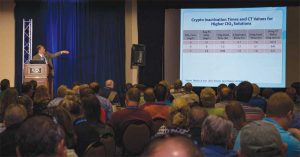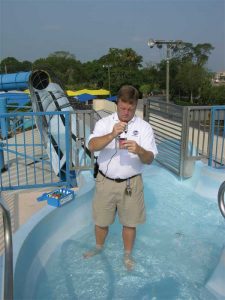Effective education incorporates the elements of sound data and practical application. While neither is effective in isolation, when combined, data and experience create solutions with dynamic impact.
The advantage of employing education and experience in tandem is illustrated by one of the most commonly taught pool and spa water chemistry topics: combined chlorine and breakpoint chlorination. Field experience has proven industry education on these topics is inadequate and can be improved. Fortunately, new science has helped advance education that more reasonably explains industry experiences. To understand where chemistry education can be improved by the application of experience, this article briefly reviews the two principles of combined chlorine and breakpoint chlorination.
Understanding combined chlorine and breakpoint chlorination
Education and experience have established the importance of testing pool water for free chlorine and total chlorine, and calculating combined chlorine. Free chlorine is commonly defined as the amount of hypochlororous acid (HOCl) and hypochlorite ion (OCl–) present in the water. Measuring the free chlorine level serves to indicate the amount of active disinfectant in the water and satisfies the product label requirement for free chlorine residuals.
When nitrogen-containing molecules like ammonia (NH3) are present in the water, free chlorine will quickly break the hydrogen to nitrogen (H-N) bond and form a chlorine to nitrogen (Cl-N) bond. For example, ammonia (NH3) will react with free chlorine to form monochloramine (Cl-NH2). Chloramine is the term used for chemicals with this nitrogen-chlorine bond.
The characteristics of chloramines are significant: they do not react as well as free chlorine, do not serve as disinfectants, and do not appear in a free-chlorine analysis, which is commonly called the DPD1 test. What raises concern about these characteristics is that trichloramine is irritating in the water and is the primary contributor to the noxious ‘chlorine-like’ odor in pool facilities. Chloramines are detected, however, when another reagent is added in a DPD3 test, which measures total chlorine. Combined chlorine is then calculated by subtracting free chlorine from total chlorine:
Total chlorine – Free chlorine = Combined chlorine
It is commonly taught that chloramines, or combined chlorine, are destroyed through breakpoint chlorination: increasing the free chlorine level to 10 times the combined chlorine level. The chemical reaction associated with breakpoint chlorination is the chlorination of ammonia to form monochloramine, dichloramine, and then trichloramine. Trichloramine breaks down further to form harmless nitrogen gas and chloride ion.
Advancing water chemistry education through experience
Experience and education concur on the practice that total chlorine and free chlorine can be tested and that chloramines are irritants and ineffective disinfectants, and science supports the ability of breakpoint chlorination to destroy ammonia-based chloramines. However, there is a common experience that indicates a flaw in combined chlorine and breakpoint education.
Water, which time after time has received adequate free chlorine to achieve breakpoint chlorination, should be free of combined chlorine, but when it is tested, combined chlorine remains. If education were correct, after breakpoint chlorination, the combined chlorine would be undetectable. Actual experience, on the other hand, indicates users continue to sense and smell nitrogen trichloride in the air.
The scientific method directs, in the presence of contradictory evidence, a hypothesis must be abandoned or modified to support the available evidence. In the example of chloramines, if breakpoint chlorination is performed and combined chlorine is still detected, ammonia cannot be the sole contributor to the formation of combined chlorine. Subsequently, the hypothesis has been modified to address another factor contributing to the presence of combined chlorine and the production of nitrogen trichloride: organic chloramines.
What are organic chloramines?

The hypothesis that organic chloramines contribute to the presence of combined chlorine in air and water has been substantiated by National Swimming Pool Foundation (NSPF)-funded research, which is published in scholarly journals and presented at the World Aquatic Health™ Conference (WAHC).
Organic chloramines have been identified as negatively affecting the pool water and surrounding air. The most common organic chloramines come from urea, found in urine and other bodily fluids. Free chlorine will break urea’s nitrogen to hydrogen (N-H) bond and form a nitrogen to chlorine (N-Cl) bond, similar to free chlorine’s reaction with ammonia.
Free Chlorine
NH2-CO-NH2 > Cl-NH-CO-NH2
Urea Monochlorourea
The difference between ammonia and urea’s chemical reaction to free chlorine is based on urea’s unique structure. It has nitrogen to carbon (N-C) bonds, while ammonia only has nitrogen to hydrogen (N-H) bonds. The N-C bond takes days or even weeks to breakdown, depending on the free chlorine concentration. Consequently, urea breaks down more slowly, producing ammonia at low levels over time. The subsequent chlorination of ammonia produces trichloramine, which irritates swimmers’ eyes and membranes and evaporates to create an offensive odor in the area nearby.
The hypothesis that organic chloramines contribute to the presence of combined chlorine in air and water has been substantiated by National Swimming Pool Foundation (NSPF)-funded research, which is published in scholarly journals and presented at the World Aquatic Health™ Conference (WAHC). In fact, the recent WAHC held in Denver, Colo., included a full-day Advanced Chemistry track led by Purdue University professor Ernest ‘Chip’ Blatchley III, Ph.D., PE, BCEE, F. ASCE, which included sessions on chemistry related to organic chloramines, chlorine, and ultraviolet light (UV).
Addressing organic chloramines
Education leading toward prevention of organic chloramines is the ultimate goal. Although perspiration cannot be prevented, water contamination from perspiration, skin cells, and cosmetics can be reduced by showering before entering the water. With urine being the primary source of urea in pools, collaborative consumer education can continue to prevent pee in the pool.
In addition to prevention, water replacement guarantees the reduction of contaminants; however, this solution is not the most environmentally friendly means to reducing and eliminating chloramines. Even partial water replacement is part of European DIN (Deutsches Institut für Normung) standards, the German national organization for standardization. Other oxidization systems, such as UV, ozone, or monopersulfate, also provide benefits.
Combining education and experience to address combined chlorine

Chloramines do not appear in a free-chlorine analysis (DPD1 test); however, they can be detected when another reagent is added in a DPD3 test, which measures total chlorine.
NSPF training and materials reinforce experience and education as vehicles for the industry to use in solving the problem of organic chloramines. In fact, Certified Pool & Spa Operator® (CPO®) Certification equips pool operators with knowledge to address the issue. The Advanced Service Technician™ training enables service technicians to identify and treat water for chloramines, as well.
Education and experience have limits when applied in isolation; the combination of the two can advance industry practices. Experience has taught that poor water and air quality are not explained by common beliefs in the industry. Education, based on good science, has taught that new approaches must be taken to address the issue. The better the industry understands combined chlorine, the more likely solutions will be created for water quality.
This article was written by Thomas M. Lachocki, Ph.D., B.Sc., and Rose M. Lyda, MPA and originally appeared on Pool & Spa Marketing [link].
